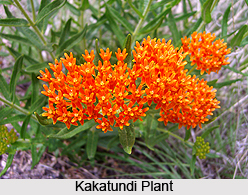 Silkweed, scientifically known as "Asclepiadaceae", is an Indian Medicinal Plant, extensively used in traditional Ayurveda. It was introduced in India as an ornamental plant from tropical America. However, presently Silkweed has been naturalized in many parts of the country at lower elevations in waste places and on roadsides. The name comes from the type genus Asclepias (milkweeds). There are 348 genera, with about 2,900 species. They are mainly located in the tropics to subtropics. Unlike most other members of the milkweed family, this species does not possess a milky sap.
Silkweed, scientifically known as "Asclepiadaceae", is an Indian Medicinal Plant, extensively used in traditional Ayurveda. It was introduced in India as an ornamental plant from tropical America. However, presently Silkweed has been naturalized in many parts of the country at lower elevations in waste places and on roadsides. The name comes from the type genus Asclepias (milkweeds). There are 348 genera, with about 2,900 species. They are mainly located in the tropics to subtropics. Unlike most other members of the milkweed family, this species does not possess a milky sap.
Different Names of Silkweed
The botanical name of Silkweed is "Asclepias Tuberosa". Silkweed is called "Bankarpas" in Bengali while "Blood Flower", "Curassavian Swallowwort", "Butterfly Weed" and "Silkweed" in English. This medicinal plant is known as "Kakatundi" in Kannada as well as in Punjabi and "Kurki" in Marathi.
Characteristic Features of Silkweed
Silkweed has a somewhat woody base rising to a height of 0.5-1.2 meters and the young stems and inflorescences are minutely puberulous. They form a group of perennial herbs, twining shrubs, lianas or rarely trees but notably also contain a significant number of leafless stem succulents. Most members of Silkweed have milky juice, flowers with five united petals, pod like fruits, and usually, tufted seeds. Male and female parts of each flower are united in a single structure, and the pollen is characteristically massed in bundles called pollinia.
The leaves are simple and nearly always opposite or whorled; minute stipules are present. The leaves are 7-15 cms long and 1.5-3 cms wide, lanceolate or oblong-lanceolate, acute at the base and acuminate at apex. The petioles are short. The flowers are orange-red in colour and grow on shortly peduncled umbel-like cymes. The fruits are erect, 6-7.5 cms long and 0.8-1 cm wide; they are straight and tapering at both ends, enclosing seeds that are 6-6.5 mm long and 4 mm wide with a thickened margin. The fruit is a follicle. Seeds usually have a tuft of hairs at one end. Flowers and fruits of Silkweed blossom from May to August.
Medicinal Values of Silkweed
Silkweed is an Indian medicinal plant which is a vertical perennial herb. All parts of Kakatundi plant are used in traditional Indian medicine and the entire plant is considered emetic, styptic, purgative and toxic. Kakatundi is used in the form of powders, balms and enemas to treat various kinds of abdominal tumours and tuberculosis. The latex is obtained from the plant, has bactericidal properties, thus used against warts and corns. The juice of the Kakatundi flowers is a good styptic. Kakatundi plants, in the form of a poultice, are also used to relieve headache.
The juice of the Kakatundi leaves has high medicinal value and is used as anti-dysenteric, anthelmintic and sudorific, often healing haemorrhages and gonorrhoea. The Kakatundi root is astringent, cathartic and used as a remedy for piles. The root powder derived from Kakatundi plant is mixed with an equal quantity of powdered "Acorus Calamus" to treat chronic ulcers. A grinded root is used against cancer. In Ayurveda, this whole medicinal plant is used to treat mental disorders, hair loss, epilepsy, leprosy, cough and as a tonic and rejuvenator.



















